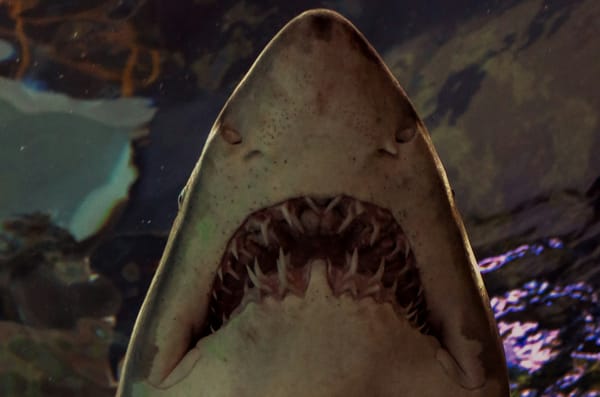The Frog Pond #26: Underwater Bees and Their Only Flower
The bee of the sea pollinates a cousin of algae that you can learn about for free since it's important to me as a nature devotee.

The bee of the sea pollinates a cousin of algae that you can learn about for free since it's important to me as a nature devotee.
The Sole Ocean Flower
Neptune grass, or Cymodoces nodosa, is a species of the only family of plants in the ocean that blooms. Similar to their counterparts above the waves, their reproductive system requires pollination1. Being underwater complicates the flowering process, but they have some tiny friends to help!
But first, a few cool facts about seagrass:
- Seagrasses were once land plants! Around 100 million years ago they transitioned to the deep blue2. These plants still require photosynthesis to feed1, similar to how whales still need to breathe air due to their landlubber ancestors. The need for sunlight keeps these plants in shallow, sheltered water along coastal shelves.
- Neptune grass sprouts flowers in spring as the water warms. Its seeds stay dormant until the next year's spring3.
- Seagrass meadows are high diversity habitats, acting as a nursery for young fish and are popular among important invertebrates to the ocean foodchain4. These meadows are also important carbon sinks that removes carbon dioxide from the ocean5! Per hectare, seagrass meadows can hold twice as much carbon dioxide as rain forests and account for more than 10% of the ocean's total carbon storage6.
- The movement of subaqueous dunes on the sea floor can be measured by studying the growth patterns of seagrass7.
- There are 17 species of seagrass under the family Cymodoceaceae, though 60 species under the larger category of "seagrass". Their age and lack of diversity is an indicator of a slow rate of evolution8.
- Seagrass pollen is made of long, thin grains rather than land flowers' spheres. This increases its surface area that enables it to form "pollen rafts", which help it spread over a larger area9.
- Hundreds of species feed on seagrasses, including green turtles, dugongs, manatees, fish (like... a lot of them), geese, swans, sea urchins, and crabs10.
- The largest known seagrass ecosystem is near the Bahamas at a whooping 92,000 square kilometers. Scientists found the site in 2022 thanks to tagged tiger sharks with cameras that could give them a new perspective11. The discovery "extends the total known global seagrass coverage by more than 40%"11. (Check out the article for a video showing the tiger shark POV!).
What's all the buzz about?
While scientists believed that seagrass pollination was only done through ocean currents, a 2016 discovery proved differently! Introducing: The idotea1! (and other isopods and worms)
This genus of isopod acts similar to a bee, swimming between the ocean flowers1. The tiny crustaceans feed on the pollen and deposit some that sticks to them to the next flower, just like a bee! the flowers have evolved a wrapping of mucilage around the pollen, a sticky substance that attaches to the idoteas1.
These "sea bees" are especially helpful to grow seagrass meadows beyond where the currents can carry. This symbiotic relationship improves water transparency, stabilizes coastlines, stores carbon, and helps protect a diverse range of species12. Some of these idoteas also help algae reproduce13, also a recent revelation.
This discovery, as reported in Science, could mean that animal-mediated fertilization may have evolved independently between terrestrial and marine life, or that the relationship developed before plants arrived on land14.
I love these little guys!!!
A word from a passing frog
It's halfway through April, which means I technically haven't missed 2 months of the Frog Pond. Yay! I have a good excuse...
Editing
I am in developmental edits for A FATE WORSE THAN DROWNING!!! I'm on deadline for late May for the first round. It's so exciting to get to say "on deadline"! So official! Mildly terrifying!
I've heard plenty of horror stories about dev edits. How they can suck out your soul and leave you with a husk of your former confidence, or how grueling the day in/day out nature can be, or how horrible a creative block can be when the clock's ticking.
Luckily that has not been the case for me (fingers crossed this continues). Overwhelming? Certainly at the start. Working with someone for the first time on highly personal and creatively challenging work intimidated me. Getting a 300+ page document back with comments on every other page is daunting, no matter how great the feedback! And it really is great--the strongest emotion I felt while scrolling through my editor's comments was relief. The changes are doable! And will make this book better!
I created a spreadsheet (shocker!) of all the edits grouped chronologically and tagged by theme. Some edits are 1 line, some are multi-chapter spanning changes. The best advice I've received on dev edits (thank you, 2026 debut group!) was simple: Count up the edits, divide by the number of days you have left, and only focus on each day's worth of work.
So until the end of May I'll be tucked away from the world making this book better, one tracked change at a time :)
Reading
I don't plan to read much over the next few weeks (other than my own words) but I did enjoy a few books since my last froggy dispatch!
Heretics of Dune by Frank Herbert: Book 5/6 is done of the Dune original series. I can't say it was a favourite, but listening along to the Gom Jabbar Podcast's book club for the book made it a lot of fun. I'll take another break before trying to finish the last book, Chapterhouse Dune.
Why Don't We Just Kill the Kid in the Omelas Hole by Isabel J. Kim: A short story you can read for free here! It's a great, funny take on the original story, with modern commentary that layers on perfectly. This story also got me re-reading the original short story by Ursula K. LeGuin, The Ones Who Walked Away From Omelas. The biggest thing that struck me on a re-read was something I don't see talked about a ton. It may be my misunderstanding or optimism, but the narrative tension of the story doesn't seem like it's primarily about the "kid in the Omelas hole", though that's a great source of discussion. The tension is between the narrator and the reader. The narrator tries over and over to get the reader to envision a world of utopia where no one suffers. It's only when the narrator has given up on the reader's ability to imagine goodness without a hidden evil that they introduce the concept of the sacrificial child. Only then does the reader seem to accept Omelas. It speaks to how fascinated we can be with evil and how little space we create in literature for good. That's my take, at least!
Sunrise on the Reaping by Susanne Collins: What can I say that hasn't already been posted? I wasn't a big fan of A Ballad of Songbirds and Snakes so I went in with careful expectations for this sequel-but-still-a-prequel following Haymitch's story. Man. Like a lot of people around my age, I have very formative memories of reading The Hunger Games and its sequels as a young adult, staying up way too late and gobbling up every word. This book felt as close as I may ever feel to the kind of fervor and rapt attention I had then. If you're a fan of the original books, this one is so worth checking out. Not many books reach that "can't stop thinking about" peak for me but this one delivered.
Everything is Tuberculosis: The History and Persistence of Our Deadliest Infection by John Green: If you read one non-fiction book this year, please let it be this one. Similar to his other non-fiction book, The Anthropocene Reviewed, this book delivered a satisfying, devastating mix of fact and feeling between John's personal connection to tuberculosis and his interest in how a bacteria that replicates so slowly become such a looming presence throughout of human history. Specifically, how the problems surrounding tuberculosis in our current age are political ones. The facts you learn may be a bit on the macabre side, but the book ends on such a hopeful, forward-thinking note that I think anyone could love it.
Fun
I have a home project I've been planning out! I bought a bookcase this week that I'm filling with all the books I've loved over the last 3ish years but could only loan out from the library due to my finances. This is a goal I've had long before my book deal that I'm so excited to be making a reality!
I've splurged a little on some wooden genre labels and a couple "book nook" kits - dioramas you put together that create a small scene in between your books.

I'll share more photos once the whole thing is put together! My current bookshelves are not particularly ~aesthetic ~ and stuffed to the gills, so putting some extra effort into making a space of things I love in a way I can enjoy has been a fulfilling project.
Footnotes
2: https://academic.oup.com/bioscience/article-abstract/62/1/56/295569
3: https://ui.adsabs.harvard.edu/abs/1991AqBot..40..343B
5: https://www.bbc.co.uk/sounds/play/m000qx0t
6: https://www.sciencedirect.com/science/article/abs/pii/S0025326X13004256?via%3Dihub
7: https://ui.adsabs.harvard.edu/abs/1994LimOc..39..126M/abstract
8: http://biotaxa.org/Phytotaxa/article/download/phytotaxa.261.3.1/20598
9: https://doi.org/10.1111%2Fj.1095-8339.1993.tb00338.x
10: https://myfwc.com/research/habitat/seagrasses/faq/
11: https://www.cnn.com/world/tiger-sharks-seagrass-ecosystem-climate-scn-c2e-spc/index.html
12: https://www.nature.com/articles/ncomms12980#additional-information
13: https://www.nytimes.com/2022/07/28/science/pollination-algae-crustacean.html





